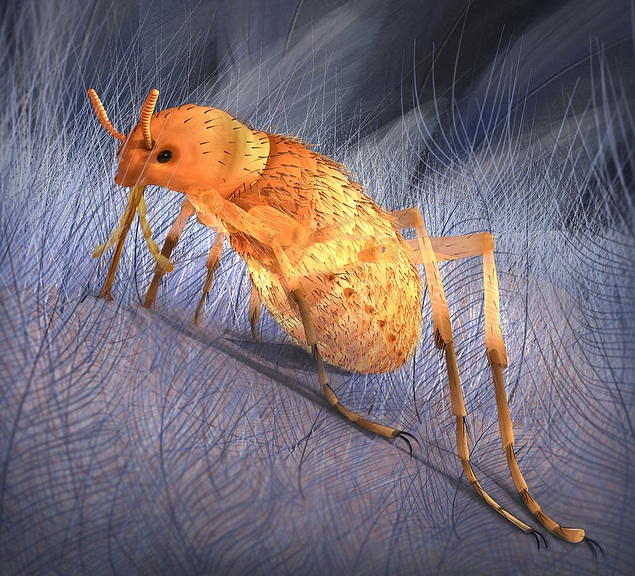Monster 'Fleas' Put the Bite on Dinosaurs

Paleo-pests about 10 times bigger than today's fleas may have sneaked up on a huge dinosaur, crawled onto its soft underbelly and taken a bite, likely a painful one, say researchers who have discovered fossils of the flealike organisms.
"It would have felt about like a hypodermic needle going in, a flea shot, if not a flu shot," George Poinar Jr., a professor emeritus of zoology at Oregon State University, said in a statement. "We can be thankful our modern fleas are not nearly this big," said Poinar, who wrote a commentary alongside the research article published online April 24 in the journal Current Biology.
One possible lifesaver for dinosaurs: These bloodsuckers couldn't jump like today's pesky fleas. Even so, past research suggests dinosaurs may have also been the first beasts tormented by lice.
The fossils of the two newly identified "flea" species, now called Pseudopulex jurassicus and Pseudopulex magnus, were discovered in Inner Mongolia. These "compression fossils," rather than impressions, are the actual preserved insects that fossilized over millions of years. [See Photos of the Dinosaur Fleas]
"These fossils have excellent preservation of detailed insect body structures, as if nature took a high-resolution photo of these creatures 165 million years ago," said Chungkun Shih, a visiting professor working with co-author Dong Ren at the Capital Normal University in Beijing.
Details of paleo-pests
The insects would have had flat bodies like a bedbug or tick, and claws long enough to reach over the scales covering a dinosaur so they could hold on while sucking its blood.
Get the world’s most fascinating discoveries delivered straight to your inbox.
Modern fleas are more laterally compressed and have shorter antennae, features that allow them to move quickly through the fur or feathers of their hosts.
The smaller of the new species, living some 165 million years ago, P. jurassicus would have been about 0.7 inches (17 millimeters) in length, not including its antennae, with mouthparts extending some 0.13 (3.4 mm), or more than twice the length of the head.
The monster of the duo, P. magnus, which lived about 125 million years ago, was even bigger, with a body length of 0.9 inches (22.8 mm) and mouthparts reaching nearly 0.20 inches (5.2 mm) in length.
This large body size as well as the long, serrated mouthparts "for piercing tough and thick skin or hides of hosts suggest that these primitive ectoparasites might have lived on and sucked the blood of relatively large hosts, such as contemporaneous feathered dinosaurs and/or pterosaurs or medium-sized mammals, found in the Early Cretaceous, but not the Middle Jurassic," Shih wrote in an email to LiveScience.
To find out which dinosaurs may have needed flea collars, the team surveyed information on coexisting animals that lived at the same time and place as these insects. During the middle Jurassic, potential feathered-dinosaur hosts may have been Pedopenna daohugouensis and Epidexipteryx hui. During the early Cretaceous, when P. magnus lived, Sinosauropteryx prima and Microraptor gui may have served as hosts, Shih noted.
More dino fleas?
The two fossil insects seem to resemble "dinosaur fleas" reported in the journal Nature last month by Diying Huang, at the Chinese Academy of Sciences, and colleagues.
"Based on reading their paper, online supplement information, and published figures, we can see some resemblance and similarity among their three taxa and our two described species," Shih said of Huang's research. "We also notice some differences among them."
Without high-resolution images and microscopy, as well as a comparison of the actual fossils, however, they can't comment on whether the fossils belong to the same species, Shih added.
Like the flealike insects described in Nature, the new species didn't have hind legs made for jumping; at some point in their evolution fleas gained the ability to catapult 50 to 100 times their body length. Even so, today's fleas seem to shy away from the biggest beasts, with 94 percent of the 2,300 known species attacking mammals, while the remainder feed on birds.
Follow LiveScience for the latest in science news and discoveries on Twitter @livescience and on Facebook.
Jeanna Bryner is managing editor of Scientific American. Previously she was editor in chief of Live Science and, prior to that, an editor at Scholastic's Science World magazine. Bryner has an English degree from Salisbury University, a master's degree in biogeochemistry and environmental sciences from the University of Maryland and a graduate science journalism degree from New York University. She has worked as a biologist in Florida, where she monitored wetlands and did field surveys for endangered species, including the gorgeous Florida Scrub Jay. She also received an ocean sciences journalism fellowship from the Woods Hole Oceanographic Institution. She is a firm believer that science is for everyone and that just about everything can be viewed through the lens of science.
